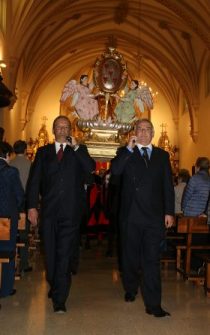Basque ethnography at a glance
Roman guards. Fernando Hualde.Holy Week celebrations are seemingly very similar; the religious structure around which they are organised and the underlying reason for holding them are the same, and Pamplona organises the same type of penitential acts as in other locations. In the case of the capital of Navarra, they include the typical Services of each holy day and the Santo Entierro (Holy Burial) procession on Good Friday evening, along with the “Seven Last Words” ceremony held in the Cathedral in the morning on that Friday. However, Pamplona has successfully added its own touches down through the centuries and which make Pamplona’s Holy Week idiosyncratic and unique. Let us look at some of its most important aspects that are not found elsewhere.
The first, of which few people are aware, is that the city of Spain holds the first procession in the lead up to Holy Week in Spain, and that happens exactly forty days earlier, i.e., on Ash Wednesday. On that day, and with the city still nursing its carnival hangover, Roman guards lead out masked penitents ―known as mozorros in Pamplona― in total silence. It is only broken by the creak of the wooden bier as it sways to the pace of the members La Pasión brotherhood carrying the paso or float of Cristo alzado (Christ on the Cross) ―the work of Fructuoso Orduna from the Roncal Valley― from the Dormitalería to Pamplona Cathedral where it is met by the cathedral’s chapter. That sombre figure spends Lent there and adds solemnity to the penitential Stations of the Cross each Friday in the run up to Holy Week.
Pamplona is also the setting of another unique, and penitential, ceremony dating right back to 1600. It is the Función de las Cinco Llagas (Five Wounds Ceremony), in other words, the renewal of the vow that the city of Pamplona made in 1599 when it was freed of the plague. It has been held every Maundy Thursday evening, before the Services, at the Parish Church of Sant Agustín since then. The City Council, using all the finery and trappings of the City Corps and following a protocol that is exclusively used six times a year, one of which is this, parades through the streets from the City Hall to the church.
A religious ceremony is held in the church, which includes a processional march around the inside of the church with the councillors carrying the effigy of the Five Wounds. The parade is, and yet again exceptionally, led by a black flag which replaces the city’s official flag on that holy day. That afternoon, and just on that occasion, the buglers of the entourage accompanying the Councillors through the streets put mufflers on their bugles to avoid a stridency unbecoming of a ceremony during Holy Week.
And if anyone wishes to continue searching for and enjoying more exclusive details of Pamplona during this holy time of the year, a real must is the Transfer of the Dolorosa and the Return of the Dolorosa; two processional acts that are followed with fervour by the believers, thousands of whom flank and accompany Our Lady of Solitude, the Dolorosa, from her refugee in the Church of San Lorenzo to Pamplona Cathedral and back again. The processions, in piercing silence, are overawing and set a different tone for seven days of penitence that tend to be overlooked compared to the showiness of the Castilian and Andalusian processions.
Fernando Hualde – Ethnographer – Labrit Heritage




